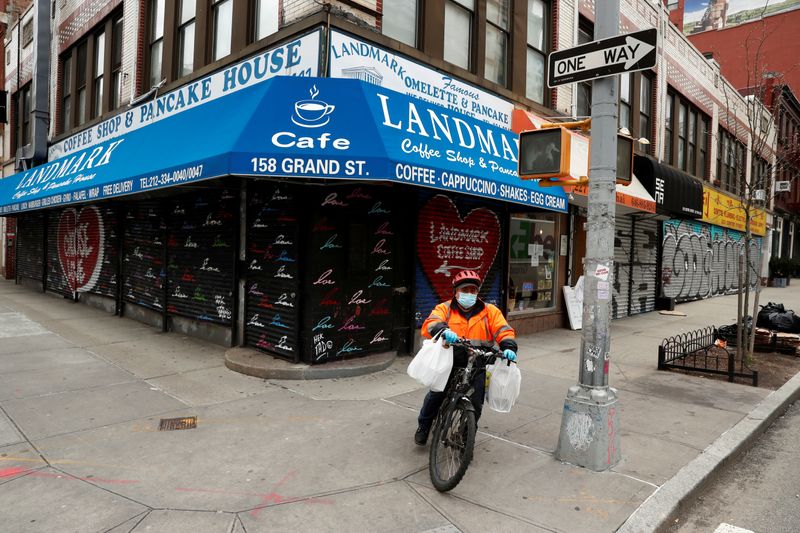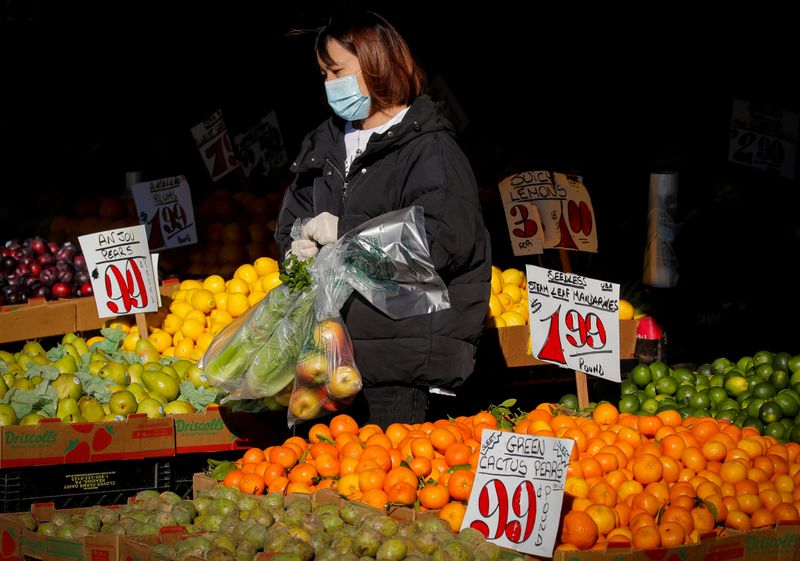WASHINGTON (Reuters) – U.S. producer prices fell by the most since 2009 in April, leading to the largest annual decline in nearly 4-1/2 years, bolstering some economists’ predictions for a brief period of deflation as the novel coronavirus depresses demand.
The report from the Labor Department on Wednesday followed data on Tuesday showing consumer prices dropping by the most since the 2007-09 Great Recession, and a measure of underlying inflation posting a record decline. It also came as Federal Reserve Chair Jerome Powell cautioned the economy could face an “extended period” of weak growth and stagnant incomes.
Lockdowns to slow the spread of COVID-19, the respiratory illness caused by the virus, have weighed on demand, with the economy contracting in the first quarter at its sharpest pace since the final three months of 2008. Deflation, a decline in the general price level, is harmful during a recession as consumers and businesses may delay purchases in anticipation of lower prices, worsening the economic downturn.
“This is yet another stark evidence that the global coronavirus recession is having a strong disinflationary effect on the economy,” said Gregory Daco, chief U.S. economist at Oxford Economics in New York. “Looking ahead, the severe demand shock from the COVID-19, the collapse of oil prices and the stronger dollar will continue to exert strong deflationary pressure on prices.”
The producer price index for final demand tumbled 1.3% last month, the biggest decline since the series was revamped in December 2009, after slipping 0.2% in March. In the 12 months through April, the PPI decreased 1.2%. That was the biggest drop since November 2015 and followed a 0.7% increase in March.
Economists polled by Reuters had forecast the PPI falling 0.5% in April and declining 0.2% on a year-on-year basis.
Stocks on Wall Street were trading lower as investors digested Powell’s comments in a webcast question & answer hosted by the Peterson Institute for International Economics. The dollar was little changed against a basket of currencies. U.S. Treasury prices were trading marginally higher.
BROAD PRICE WEAKNESS
Excluding the volatile food, energy and trade services components, producer prices plunged 0.9% in April, the biggest drop since the introduction of the series in September 2013.
The so-called core PPI fell 0.2% in March and has now declined for three straight months. In the 12 months through April, the core PPI decreased 0.3%. That was the first 12-month drop in core PPI and followed a 1.0% increase in March.
The Fed tracks the core personal consumption expenditures (PCE) price index for its 2% inflation target. The core PCE price index increased 1.7% year-on-year in March after rising 1.8% in February. April’s core PCE price index data will be released at the end of the month.
In April, wholesale energy prices collapsed 19.0% after tumbling 6.7% in March. They were depressed by a 56.6% dive in gasoline prices, the largest decrease since the series began in February 1947. That followed a 16.8% drop in March.
Gasoline accounted for two-thirds of the decrease in the cost of goods last month. Goods prices fell 3.3% in April, the largest decline since the series was revamped in December 2009, after declining 1.0% in the prior month. Wholesale food prices dropped 0.5% last month after being unchanged in March.
The decline in wholesale food prices was in stark contrast to the surge in food prices at the consumer level last month, which rose at the fastest pace since January 1990, consumer price data showed on Tuesday.
The sharp drop in wholesale goods prices accounted for more than 80% of the decrease in the PPI last month. Core goods prices fell 0.4% in April after gaining 0.2% in March.
“Factory production is falling and bringing down the prices of producer goods,” said Chris Rupkey, chief economist at MUFG in New York. “Inflation isn’t coming back in this economy for a long, long time. These are the worst of times for many manufacturers and it will take years for strengthening demand to bring them back to full capacity.”
The cost of services fell 0.2% last month, reversing March’s 0.2% gain. Services were held down by decreases in the costs of airline tickets and hotel and motel accommodation. Prices for apparel, footwear and accessories also fell.
The cost of healthcare services was unchanged in April for a second straight month. Portfolio management fees plummeted 12.0% last month after dropping 0.8% in March. Those healthcare, travel and portfolio management costs feed into the core PCE price index.
Taken together with other details from Tuesday’s CPI report, JPMorgan is forecasting the core PCE price index falling 0.4% in April and increasing 1.0% year-on-year.
“This would be an unusually large monthly decline for the core index, but not quite the largest on record,” said Daniel Silver, an economist at JPMorgan in New York. “There is greater-than-normal uncertainty for our core PCE tracking given that some of the categories with recent large price changes also likely have seen large changes in consumption volumes.”
(Reporting By Lucia Mutikani; Editing by Andrea Ricci)




















